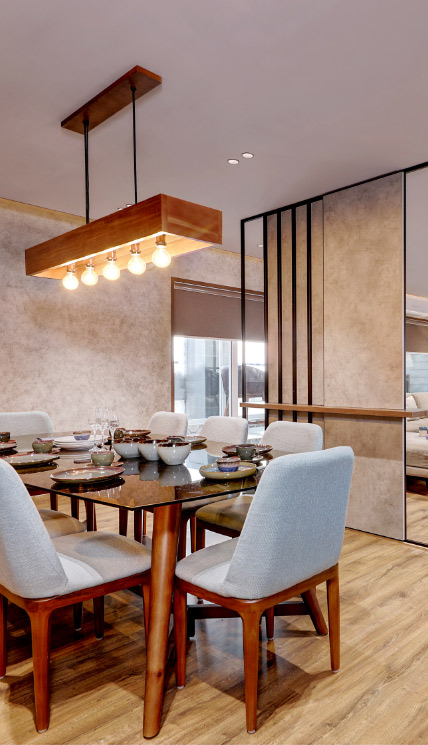Premier interior design firms specialize in high-end transformations.
Change Your Home With Essential Principles of Interior Decoration and Looks
By understanding the impact of shade theory and the significance of appearance and patterns, one can produce spaces that are not just aesthetically appealing yet likewise deeply personal. Attaining this balance involves even more than simple decoration; it incorporates a calculated arrangement and an eager understanding of how each component engages within a space.
Recognizing Color Concept
Recognizing the principles of color concept enables developers to create areas that reverberate emotionally with residents while meeting functional requirements. Each classification plays a crucial role in developing consistency within a room.
The psychological effect of shades is profound; warm hues such as reds and oranges stimulate energy and warmth, while great tones like blues and environment-friendlies promote peace and serenity. Furthermore, using complementary colors boosts aesthetic interest, producing striking contrasts that can boost a room's appeal.
Neutral shades, on the various other hand, work as a functional background, permitting various other layout components to beam. It is vital to consider elements such as lighting and the room's purpose when selecting a color palette, as these can alter the perception of shades throughout the day.
Inevitably, a well-considered shade plan can change an area, fostering a sense of convenience and design that straightens with the occupants' choices. Mastery of color concept is, consequently, an essential ability for any type of interior developer intending to produce harmonious and welcoming settings.
Attaining Balance in Design
How can developers achieve a sense of stability in their rooms? Accomplishing equilibrium in design is essential to creating unified interiors.
Unbalanced balance, on the various other hand, depends on varying elements that still attain a cohesive appearance. This approach enables for more dynamic and casual arrangements, giving interest while keeping equilibrium. By meticulously selecting differing dimensions, colors, and structures, designers can produce an aesthetically compelling area that really feels balanced yet energised.
Radial equilibrium highlights a main centerpiece with elements emitting exterior. This style is frequently seen in round layouts, where furniture and decoration develop a cohesive surround that draws the eye internal.
Ultimately, achieving balance needs thoughtful factor to consider of range, proportion, and the relationships between aspects. miami luxury interior design. By masterfully using these equilibrium concepts, developers can change rooms into environments that feel both aesthetically pleasing and functionally harmonious, improving the general experience for passengers
Significance of Spatial Awareness

An eager feeling of spatial recognition permits designers to identify centerpieces within a room, directing the customer's interest to crucial attributes while keeping a total feeling of unity. It additionally assists in the strategic positioning of lighting, which can significantly influence the Check This Out perception of space and mood. Furthermore, understanding spatial relationships enables the developer to satisfy the details demands of occupants, making sure that each location serves its intended purpose without endangering visual appeals.
Ultimately, spatial awareness is critical for maximizing the possibility of any type of interior area. By thoroughly considering the interaction between measurements, design, and function, developers can develop settings that not only fulfill functional requirements yet also stimulate a sense of convenience and appeal, enhancing the general living experience.
Including Structure and Patterns
Welcoming a diverse series of structures and patterns can considerably boost the visual and responsive appeal of an indoor room. The calculated use different products-- such as wood, metal, textile, and stone-- develops depth and rate of interest, making a room feel extra inviting and vibrant. For example, integrating smooth surface areas with rough structures can develop a balance that draws the eye and involves the detects.
When including patterns, consider look these up both scale and repeating. Huge patterns can serve as prime focus, while smaller sized, refined designs can complement other components without frustrating the space. Layering patterns, such as pairing floral pillows with candy striped tosses, adds complexity and a sense of harmony if carried out attentively.
It is additionally critical to keep a natural shade combination, making sure that structures and patterns interact instead of complete for focus. By picking a few essential textures and patterns, you can create a linked visual that shows your personal style while boosting the general atmosphere of the room. Ultimately, the mindful unification of these aspects can transform an ordinary area into a sophisticated setting rich with character and heat.
Customizing Your Space
Developing an area that reflects your individuality is crucial to accomplishing a truly welcoming atmosphere. Personalization in indoor style allows you to instill your unique design and interests right into your home, transforming it click to read from a plain shelter right into a shelter that talks with that you are. Begin by selecting a shade combination that reverberates with your emotions-- vibrant colors can energize, while soft tones use serenity.
Include artwork and style that reflect your passions, whether it be traveling, nature, or abstract principles. Displaying individual collections, such as publications, photos, or souvenirs, can stimulate valued memories and produce centerpieces within a room. In addition, think about tailoring functional pieces, like upholstered furnishings, to align with your visual choices.

Conclusion
To conclude, the makeover of a home through the necessary concepts of interior style and aesthetics requires a detailed understanding of shade theory, balance, spatial understanding, structure, and customization. Each element contributes significantly to creating an unified and practical living atmosphere - luxury interior design. By thoughtfully integrating these principles, individuals can improve the aesthetic charm and psychological vibration of their rooms, inevitably cultivating a home that mirrors unique identities while providing convenience and practicality